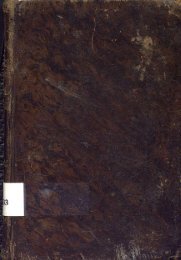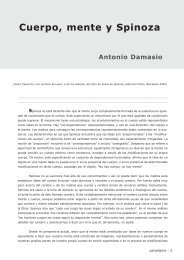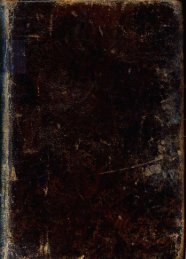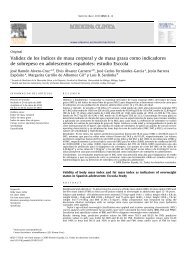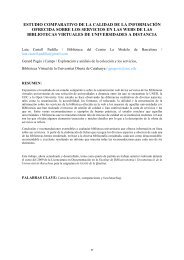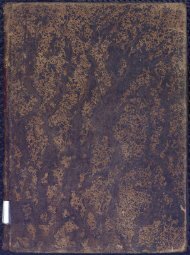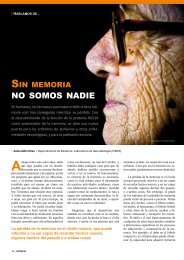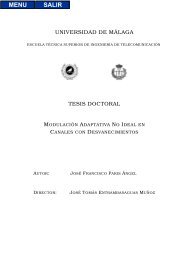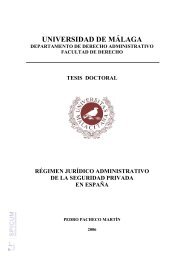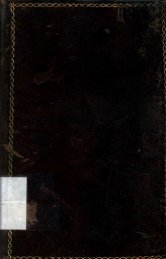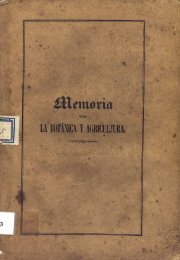Papel de las actividades superóxido dismutasa y catalasa en la ...
Papel de las actividades superóxido dismutasa y catalasa en la ...
Papel de las actividades superóxido dismutasa y catalasa en la ...
Create successful ePaper yourself
Turn your PDF publications into a flip-book with our unique Google optimized e-Paper software.
2.6.3. PCR amplification<br />
Two differ<strong>en</strong>t sets of primers were tested in this study to select those that yiel<strong>de</strong>d<br />
the best results to compare DGGE patterns based on their resolution and observed<br />
diversity (Table 1). Primer set Bact-0968-GC-F / Bact-1401-R was used to amplify the<br />
V6 to V8 regions of the 16S rRNA g<strong>en</strong>e [47, 48] and PRBA-338-GC-F and PRUN-518-<br />
R amplified the V3 hypervariable region [44]. PCR was performed using the Taq DNA<br />
polymerase kit from Life Technologies (Gaithersburg, Md). PCR mixtures (50 μl)<br />
contained 0.5 μl Taq polymerase (1.25 U), 20 mM Tris-HCl (pH 8.5), 50 mM KCl, 3<br />
mM MgCl 2 , 200 μM of each <strong>de</strong>oxynucleosi<strong>de</strong> triphosphate, 5 pmol of the primers, 1 μl<br />
of DNA temp<strong>la</strong>te, and UV-sterilized water. The samples were amplified in a T1<br />
thermocycler (Whatman Biometra, Götting<strong>en</strong>, Germany), and the cycling conditions for<br />
each pair of primers are listed in Table 1. Aliquots (5 μl) were analyzed by<br />
electrophoresis on 1.5% (wt/vol) agarose gels containing ethidium bromi<strong>de</strong> to check for<br />
product size and quantity.<br />
2.6.4. DGGE analysis<br />
The amplicons obtained from the intestinal lum<strong>en</strong>-extracted DNA and the<br />
probiotic strains were separated by DGGE according to the specifications of Muyzer et<br />
al. [39] using a Dco<strong>de</strong> TM system (Bio-Rad Laboratories, Hercules, CA).<br />
Electrophoresis was performed in an 8% polyacry<strong>la</strong>mi<strong>de</strong> gel (37.5:1 acry<strong>la</strong>mi<strong>de</strong>bisacry<strong>la</strong>mi<strong>de</strong>;<br />
dim<strong>en</strong>sions, 200 by 200 by 1 mm) using a 30 to 55% <strong>de</strong>naturing gradi<strong>en</strong>t<br />
for separation of PCR products. The gels contained a 30 to 55% gradi<strong>en</strong>t of urea and<br />
formami<strong>de</strong> increasing in the direction of the electrophoresis. A 100% <strong>de</strong>naturing<br />
solution contained 7 M urea and 40% (vol/vol) <strong>de</strong>ionized formami<strong>de</strong>. PCR samples<br />
were applied to gels in aliquots of 13 μl per <strong>la</strong>ne. The gels were electrophoresed for 16<br />
h at 85 V in 0.5 X TAE (20 mM Tris acetate [pH 7.4], 10 mM sodium acetate, 0.5 mM<br />
Na 2 -EDTA) [50] buffer at a constant temperature of 60 ºC and subsequ<strong>en</strong>tly stained<br />
with AgNO 3 [51].<br />
Gel image processing and comparative analysis of banding patterns was done<br />
with Bionumerics version 4.0 (Applied Maths BVBA, Sint-Mart<strong>en</strong>s-Latem, Belgium).<br />
Simi<strong>la</strong>rity betwe<strong>en</strong> DGGE profiles was <strong>de</strong>termined by calcu<strong>la</strong>ting simi<strong>la</strong>rity indices of<br />
8



